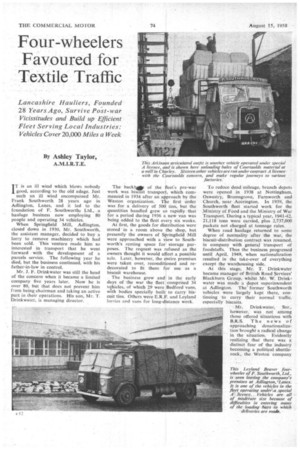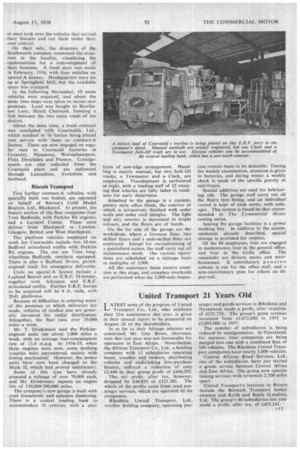Four-wheelers Favoured for Textile Traffic
Page 50

Page 51

If you've noticed an error in this article please click here to report it so we can fix it.
Lancashire Hauliers, Founded 28 Years Ago, Survive Post-war Vicissitudes and Build up Efficient Fleet Serving Local Industries: Vehicles Cover 20,000 Miles a Week By Ashley Taylor, A.M.I.R.T.E.
IT is an ill wind which blows nobody good, according to the old adage. Just such an ill wind encompassed Mr. Frank Southworth 28 years ago in Adlington, Lancs, and it led to the foundation of F. Southworthr Ltd., _a haulage business now employing 80 people and operating 34 vehicles.
When Springfield Mill, Adlington, closed down in 1930, Mr. Southworth, the assistant manager, decided to buy a lorry to remove machinery which had been sold. This venture made him so interested in transport that he went forward with the development of a parcels service. The following year he died, but the business continued, with his father-in-law in control.
Mr. J. F. Drinkwater was still the head of the concern when it became a limited company five years later. Now he is over 80, but that does not prevent him from being chairman and taking an active part in their operations. His son, Mr. T. Drinkwatcr, is managing director. The back of the fleet's pre-war
work was biscuit transport, which commenced in 1934 after an approach by the Weston organization. The first order was for a delivery of 500 tins, but the quantities handled grew so rapidly that for a period during 1936 a new van was being added to the fleet every six weeks.
At first, the goods for distribution were stored ' in a room above the shop, but presently the owners of Springfield Mill were approached with a view to Southworth's renting space for storage purposes. The request was refused as the owners thought it would affect a possible sale. Later, however, the entire premises were taken over, reconditioned and redecorated to fit them for use as a biscuit warehouse.
. The business grew and in the early days of the war the fleet comprised 34 vehicles, of which 29 were Bedford vans, with bodies specially built to carry biscuit tins. Others were E.R.F. and Leyland lorries and vans for long-distance work. To reduce dead mileage, branch depots were opened in 1938 at Nottingham, Oswestry, Bromsgrove, Farnworth and Church, near Accrington. In 1939, the Southworth fleet started work for the Ministry of Food and the Ministry of War Transport. During a typical year, 1941-42, 21,118 tons were carried, plus 2,737,000 packets not charged at tonnage rates.
When road haulage returned to some degree of normality after the war, the biscuit-distribution contract was resumed, In company with general transport of foodstuffs. Thus the business progressed until April, 1949, when nationalization resulted in the take-over of everything except the warehousing side.
At this stage, Mr. T. Drinkwater became manager of British Road Services' Blackburn Group, whilst Mr. W. Drinkwater was made a depot superintendent at Adlington. The' former Southworth vehicles were largely kept there, continuing to carry their normal traffic, especially biscuits.
Mr. Drinkwater, Snr., however, was not among those offered situations with B.R.S. The news of approaching denationalization-brought a radical change in the situation. Evidently realizing that there was a distinct fear of the industry becoming a political shuttlecock, the Weston company
at once took over the vehicles that carried their biscuits and ran them under their own control. • On their side, the directors of the Southworth company examined the situation in the locality, visualizing the opportunities for a redevelopment of their business. A fresh start was made in February, 1954, with four vehicles on special-A licence. Headquarters were set up at Springfield Mill, but the available space was cramped.
In the following November, 10 more vehicles were acquired, and about the same time steps were taken to secure new premises. Land was bought in Rawlinson Lane, Heath Charnock, forming a link between the two main roads of the district.
About the same time, a fresh contract was concluded with Courtaulds, Ltd., which resulted in 16 lorries being placed into service with them on contract-A licence. These are now engaged on regular runs to Courtauld factories at Coventry, Nuneaton, Wolverhampton, Droylsden and Preston. Consignments are also collected from the Courtauld plant and are redirected through Lancashire, Yorkshire and Scotland,
Biscuit Transport
Five further contract-A vehicles, with specially built van bodies, are operated on behalf of Burton's Gold Medal Biscuits, Ltd., Blackpool. At present, the biscuit section of the fleet comprises four 7-ton Bedfords, with Perkins R6 engines, and a Leyland Comet. These units deliver from Blackpool to . London, Glasgow, Bristol and West Hartlepool.
The platform vehicles employed on work for Courtaulds include two 10-ton Bedford articulated outfits with Perkins R6 engines. The rest are 7-ton longwheelbase Bedfords, similarly equipped. There is also a Bedford 30-cwt. petrolengined truck for emergency deliveries.
Units on special-A licence include a Leyland Beaver and an E.R.F. 14-tonner, together with Atkinson and E.R.F. articulated outfits, Further E.R.F. lorries to be acquired will be 8 ft, wide, with 20-ft, platforms.
Because of difficulties in entering many of the premises to which deliveries are made, vehicles of modest size are generally favoured for radial distribution. Altogether, the fleet runs over 20,000 miles a week.
• Mr. T. Drinkwater said the Perkinsengined units ran about 1,000 miles a week, with an average fuel-consumption rate of 13.4 m.p.g. In 1954-55, when these engines were new, some teething troubles were encountered, mainly with timing mechanise However, the power units' have now been changed to the Mark 11, which had proved satisfactory.
Some of this type have already amassed a mileage of over 70,000 each, and Mr. Drinkwater expects an engine life of 150,000-200,000 miles.
The company's new garage is built with steel framework and asbestos shuttering. There is a central loading bank to accommodate 16 vehicles. with a plat
form of saw-edge arrangement. Handling is mainly manual, but two fork-lift trucks, a Towmaster and a Clark, are employed. Transhipment is performed at night, with a loading staff of 12 ensuring that vehicles are fully laden in readiness for early departures.
Attached to the garage is a contemporary style office block, the exterior of which is attractively finished with cedar walls and cedar roof shingles. The light and airy interior is decorated in bright colours, and the floors are of beech.
On the far side of the garage are the workshops, where a foreman fitter, two• skilled fitters and a serhi-skilled fitter are employed. Except for reconditioning of a specialized nature, the staff carry out all maintenance work. The various operations are scheduled on a mileage basis in multiples of 3,000.
All the customary items receive attention at this stage, and complete overhauls are performed when the 3,000-mile inspec tion reveals them to be desirable. During the weekly examination, attention is given to batteries, and during winter a weekly check is 'made of the specific gravity of anti-freeze.
Special additives are used for lubricating oils, The garage staff carry out all the fleet's tyre fitting, and an individual record is kept of each cover, with mileages. This system is based on that recommended in The Commercial Motor costing series.
Among the garage facilities is a power washing bay. la addition to the accommodation already described, special storage is provided for empties.
Of the 80 employees, four are engaged in maintenance, four in the general office, and four in the traffic office. The remainder are drivers, mates and warehousemen. A contributory p ens ion scheme is run for the office staff, and a non-contributory plan for others on the pay-roll.












































































































